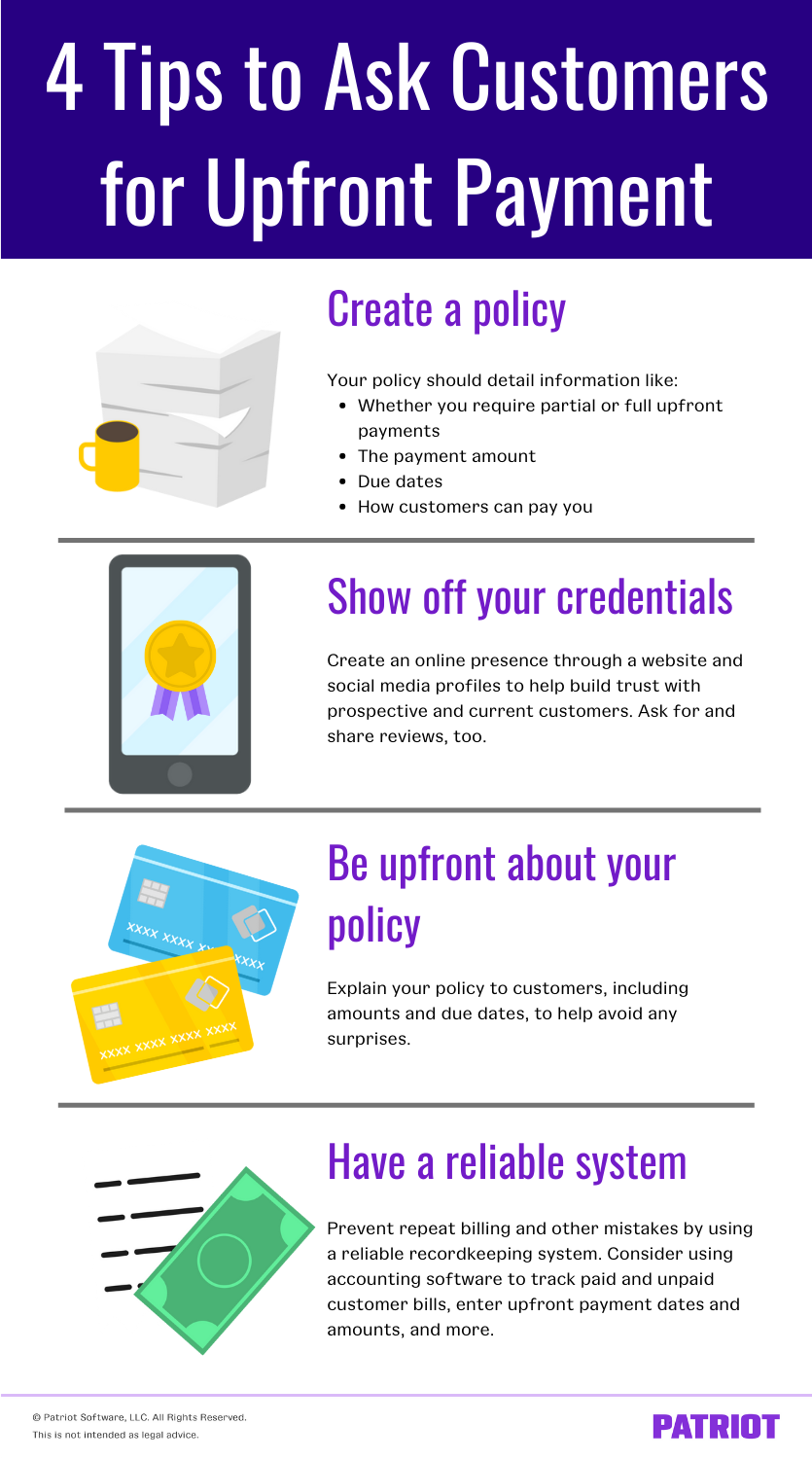Nearly three-quarters of business owners are dealing with rising costs of supplies. To help you pay for higher-than-normal supply prices, you might need to use credit for projects until you get paid. One alternative to racking up liabilities? You can ask customers for an upfront payment.
Read on to learn:
- What is an upfront payment?
- Pros and cons of asking customers to pay upfront
- 4 Tips to ask customers for a deposit or full upfront payment
What is an upfront payment?
Want customers to pay for part (or all) of a project before you get started? If so, you can ask for an upfront payment. An upfront payment policy requires that customers pay a deposit before you start or finish a project. This is common among contractors, freelancers, and service-based businesses.
Upfront payments can be:
- Flat-rate deposits (e.g., $1,000)
- Percentage-based deposits (e.g., 25% of the total estimate)
- Complete upfront payments (i.e., 100% of the total bill upfront)
Although it’s called an “upfront” payment, the timing can vary. For example, you can ask customers for an upfront payment to book your services, after booking but before you buy supplies and start on a project, or midway through a project.
Pros and cons of asking customers to pay upfront
Before making upfront payments part of your policy, weigh the pros and cons.
First, the pros. Asking customers to pay upfront can:
- Reduce risk: There’s nothing worse than pouring your blood, sweat, and tears into a job and getting stiffed by the customer. Receiving payment before you start a project negates the potential of customers who won’t pay.
- Help you pay for supplies: Strapped for cash or facing rising supply costs? Getting an upfront payment provides you with enough income to purchase what you need for the job.
- Save time: Say goodbye to hounding customers for payment post-project completion. Asking for full upfront payment can save you time sending out payment reminders and, in some cases, going through an invoice collection process.
- Boost cash flow: In addition to giving you the money you need for the job, getting money upfront can increase your overall cash flow.
And now, the cons. Although an upfront cash payment (or check, card, etc.) can be beneficial for your business, consider the potential drawbacks:
- Lost business: Prospective customers may go with someone else if they’re uncomfortable paying you beforehand (especially if you haven’t worked together before).
- Unexpected expenses: Sure, you may have sent the customer an estimate, but things happen in projects. You may get hit with an unexpected business expense and time commitment that you need to bill the customer for at the end of the project anyway.
4 Tips to ask customers for a deposit or full upfront payment
Want to boost your upfront payment request success rate (say that three times fast!)? Give the following four tried and true tips a chance.

1. Create a policy
Your first step in asking customers to pay upfront is creating a consistent policy. Your policy should detail:
- Whether you require partial or full payments upfront
- The upfront payment amount (e.g., flat rate or percentage)
- When the upfront payment is due (e.g., before booking services, one week before the project start date, partway through a project, etc.)
- Whether you offer an early payment discount for customers who pay 100% in full up front
- How customers can pay you (e.g., check, card, cash, etc.)
- When you’ll collect the remaining balance due (if partial upfront payment)
2. Show off your credentials
Nobody wants to be scammed. And if someone’s been burned before, they may be skeptical about paying upfront. So before you even ask for payment, be ready to show off your credentials.
Build trust with prospective and current customers by creating an online presence. That way, they can feel more secure that you won’t take their money and run.
Create a website, social media profiles, and Google Business profile to legitimize your business and let customers learn more about you.
Having an online presence also helps you show off why you’re right for the job. You can show photos of your work, provide a brief history of you and your business, and offer resources (e.g., blog).
One of the major ways you can show off your credentials online is through reviews. Ask customers to share their experiences on review sites, social media, and your Google Business profile. Use reviews to help you build trust with potential customers.
Not sold on the power of reviews? Check out the following review-related stats:
- 97% of people read reviews of local businesses
- Online reviews influence 67.7% of purchasing decisions
- 78% of people trust online reviews as much as a friend’s or family member’s recommendation
When asking customers—especially new customers—for a partial or full upfront payment, share reviews to help build trust and put their mind at ease.
3. Be upfront about your upfront payment policy
When you first start seriously working with a potential customer and discuss pricing, let them know that you require a partial or full upfront payment. That way, there are no surprises.
Explain your policy, including amounts and due dates. Be prepared to justify your request for upfront payment professionally.
You may need to detail:
- Why you require a partial or full upfront payment
- What the payment goes toward (e.g., supplies)
- Whether you offer refunds
- When you’ll complete the project
- What will happen if there are unexpected delays or expenses
4. Have a reliable recordkeeping system
You’re performing services for a customer totaling $5,000. The customer gave you a $1,000 upfront payment and now owes the remaining $4,000. But—oops—you forgot how much they paid and bill them the full $5,000.
Sure, mistakes happen. But the last thing your customer wants to see is a final bill that doesn’t reflect their upfront payment deposit. To prevent repeat billing, you need a reliable recordkeeping system.
Consider using accounting software to keep track of paid and unpaid bills from customers. With accounting software, you can easily enter upfront payment dates and amounts.




